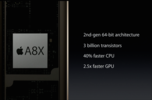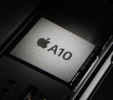Apple a8x vs apple a10
Comparison of the technical characteristics between the processors, with the Apple A10 Fusion on one side and the Apple A8X on the other side. The first is dedicated to the smartphone sector, It has 4 cores, 4 threads, a maximum frequency of 2.3GHz. The second is used on the tablet segment, it has a total of 3 cores, 3 threads, its turbo frequency is set to 1.5 GHz. The following table also compares the lithography, the number of transistors (if indicated), the amount of cache memory, the maximum RAM memory capacity, the type of memory accepted, the release date, the maximum number of PCIe lanes, the values obtained in Geekbench 4 and Cinebench R15.
Specifications:
| Processor | Apple A10 Fusion | Apple A8X |
| Market (main) | Smartphone | Tablet |
| ISA | ARMv8.1-A (64-bit) | ARMv8.0-A (64-bit) |
| Microarchitecture | Hurricane, Zephyr | Typhoon |
| Family | A series | A series |
| Part number(s), S-Spec | APL1W24 | APL1012 |
| Release date | Q3 2016 | Q3 2016 |
| Lithography | 16 nm FinFET | 20 nm |
| Transistors | 3,300,000,000 | 3,000,000,000 |
| Cores | 4 | 3 |
| Threads | 4 | 3 |
| Base frequency | 1.3 GHz | 1.5 GHz |
| Turbo frequency | 2.3 GHz | — |
| Energy cores | 2x Apple Zephyr @ 1.3 GHz | — |
| High performance cores | 2x Apple Hurricane @ 2.34 GHz | 3x Apple Typhoon @ 1.5 GHz |
| Cache memory | 4 MB | 4 MB |
| Max memory capacity | 3 GB | 2 GB |
| Memory types | LPDDR4 | LPDDR4 |
| Max # of memory channels | 4 | 4 |
| Max memory bandwidth | 51.2 GB/s | 25.6 GB/s |
| TDP | 5 W | 5 W |
| GPU integrated graphics | Imagination PowerVR GT7600 Plus | Imagination PowerVR GXA6850 |
| GPU execution units | 6 | 8 |
| GPU shading units | 192 | 256 |
| GPU boost clock | 900 MHz | 450 MHz |
| GPU FP32 floating point | 364.8 GFLOPS | 230.4 GFLOPS |
| Socket | SoC | SoC |
| AnTuTu | 179,650 | 109,900 |
| (iOS) PassMark CPU Mark | 2,526 | 2,113 |
| (iOS 64-bit) Geekbench 4 single core | 3,358 | 1,798 |
| (iOS 64-bit) Geekbench 4 multi-core | 5,692 | 4,356 |
| (SGEMM) GFLOPS performance | 88.2 GFLOPS | 57.5 GFLOPS |
| (Multi-core / watt performance) Performance / watt ratio | 1,138 pts / W | 871 pts / W |
| Amazon |  |  |
| eBay |  |  |
We can better compare what are the technical differences between the two processors.
Price: For technical reasons, we cannot currently display a price less than 24 hours, or a real-time price. This is why we prefer for the moment not to show a price. You should refer to the respective online stores for the latest price, as well as availability.
The processor Apple A10 Fusion has more cores, the maximum frequency of Apple A10 Fusion is greater, that their respective TDP are of the same order. Both were produced in the same year.
Performances :
Performance comparison between the two processors, for this we consider the results generated on benchmark software such as Geekbench 4.
| AnTuTu — Total score | |
|---|---|
Apple A10 Fusion | 179,650 |
Apple A8X | 109,900 |
The difference is 63%.
AnTuTu is one of the most popular apps in the world to evaluate and compare the power of a mobile device with the competition. It tests above all the power of calculation, the display of Web pages, the modeling of decorations in 3D, the management of the memory, the transfer of data.
| iOS PassMark — CPU Mark | |
|---|---|
Apple A10 Fusion | 2,526 |
Apple A8X | 2,113 |
The difference in performance is 20%.
PassMark is a benchmarking software that performs several performance tests including prime numbers, integers, floating point, compression, physics, extended instructions, encoding, sorting. The higher the score is, the higher is the device capacity.
| Geekbench 4 — Multi-core & single core score — iOS 64-bit | |
|---|---|
Apple A10 Fusion | 3,358 5,692 |
Apple A8X | 1,798 4,356 |
In single core, the difference is 87%. In multi-core, the differential gap is 31%.
Geekbench 4 is a complete benchmark platform with several types of tests, including data compression, images, AES encryption, SQL encoding, HTML, PDF file rendering, matrix computation, Fast Fourier Transform, 3D object simulation, photo editing, memory testing. This allows us to better visualize the respective power of these devices. For each result, we took an average of 250 values on the famous benchmark software.
Источник
Apple A8X vs Apple A10X Fusion vs Apple A10 Fusion
Apple A8X
The Apple A8X is a high-end ARM SoC (System on a Chip) introduced in October 2014 alongside the iPad Air 2. The three CPU cores are clocked slightly higher than the two inside the Apple A8 (+100 MHz). Apple claims a 40% improvement over the 1.3 GHz Apple A7 compared to just 20% from the A8. Furthermore, the A8X integrates a much more powerful GPU (2x 4-core PowerVR Series 6XT (Rogue) GXA6850) as well as a 128-bit LPDDR3 memory controller.
With Cyclone 2, Apple has managed to improve the already high performance-per-clock of the original Cyclone core (Apple A7) by another 10 to 15 percent. Neither Qualcomm’s Krait nor ARM’s Cortex-A57 can compete with the resulting IPC. The exact design changes have not been revealed, but we would expect enlarged caches and registers as well as an optimized branch prediction. As an ARMv8 architecture, Cyclone 2 is 64-bit capable.
Compared to the previous Apple A7, the A8X offers about 20 — 70 percent more performance. Especially the multi-thread performance has been significantly improved thanks to the third CPU core, whereas the single-thread power is just slightly higher (
20 percent). According to Geekbench 3 scores, the A8X is the fastest mobile ARM-SoC as of late 2014. However, the chip clearly benefits from the 64-bit support in the iOS version of the benchmark. Without this advantage, Nvidia’s Tegra K1 (Denver) dual-core is still somewhat faster in single-thread software (but slower in multi-thread tests).
In contrast to previous speculations, the A8X integrates an 8-cluster PowerVR Series 6 (Rogue) GXA6850 consisting of two GX6450 GPUs (2x 4 clusters) instead of a single GX6650 (6 clusters). The name GXA6850 has been created by Anandtech, the design may also be called a GX6450MP2.
Each cluster offers four FP16 and two FP32 ALUs, leading to a compute power of about 230 GFLOPS FP32 at 450 MHz (clock rate estimated). The GXA6850 does not only beat the Qualcomm Adreno 420 (Snapdragon 805), but also the Nvidia Tegra K1 by a small margin. Thus, the GXA6850 is one of the fastest tablet GPUs as of 2014 and can handle even the most demanding mobile games in high resolutions. Among others, the GPU supports OpenGL 3.x/4.x, OpenGL ES 3.0 as well as DirectX 10.
In contrast to previous Apple SoCs, the A8 und A8X are manufactured by TSMC instead of Samsung. Using a brand-new 20 nm process, the SoC consists of a whopping 3 billion transistors. Power consumption should be similar to competing high-end SoCs by Qualcomm or Samsung.
Apple A10X Fusion
The Apple A10X Fusion is a system on a chip (SoC) from Apple that is built into the 2017 iPad Pro models. It integrates six 64 Bit cores that are divided in two clusters. Three high performance cores are clocked at up to 2.39 GHz. The three power saving cores are used for non demanding tasks. It looks like only one of both clusters is able to run at a time (therefore the apps see only three cores). The principle is similar to the first generation of ARMs big.LITTLE concept.
The performance of the SoC is positioned in the high and and clearly faster than all previous Apple SoCs. Even compared to Android high-end SoCs like the Snapdragon 835, the A10X takes the lead (e.g. in Geekbench or Antutu).
The integrated graphics card of the SoC will most likely stem from PowerVR (again) and features 12 cores instead of 6 in the A10 SoC.
According to TechInsights, the A10X is manufactured in the brand new 10 nm FinFet process at TSMC. Altough it offers more function blocks, the A10X is with measured 96.4 mm2 significantly smaller than the previous A9X (143.9 mm2).
Apple A10 Fusion
The Apple A10 Fusion is a system on a chip (SoC) from Apple that is built into the iPhone 7 and iPhone 7 Plus. It integrates four 64 Bit cores that are divided in two clusters. Two high performance cores are clocked at up to 2.34 GHz and should be around 40% faster than the Apple A9 (according to Apple) and two low power cores (up to 1.1 GHz?). Up to now its unclear if all four cores can be used at once (that need only 1/5 th of the energy in some use cases). At the release of the iPhone 7 it looks like that IOS is only using two cores at a time and automatically switches between the two clusters. Therefore, apps are seeing only a dual core. The principle is similar to the first generation of ARMs big.LITTLE concept.
The integrated graphics card of the SoC will most likely stem from PowerVR (again) and perform 50% faster at 2/3 of the power consumption (according to Apple).
All in all the chip includes 3.3 billion transistors, which is more than a current AMD Bristol Ridge (3.1) and Skylake Quad-Core (1.75) X86 SoCs.
Источник
Apple A8X vs Apple A10 Fusion vs Apple A8
Apple A8X
The Apple A8X is a high-end ARM SoC (System on a Chip) introduced in October 2014 alongside the iPad Air 2. The three CPU cores are clocked slightly higher than the two inside the Apple A8 (+100 MHz). Apple claims a 40% improvement over the 1.3 GHz Apple A7 compared to just 20% from the A8. Furthermore, the A8X integrates a much more powerful GPU (2x 4-core PowerVR Series 6XT (Rogue) GXA6850) as well as a 128-bit LPDDR3 memory controller.
With Cyclone 2, Apple has managed to improve the already high performance-per-clock of the original Cyclone core (Apple A7) by another 10 to 15 percent. Neither Qualcomm’s Krait nor ARM’s Cortex-A57 can compete with the resulting IPC. The exact design changes have not been revealed, but we would expect enlarged caches and registers as well as an optimized branch prediction. As an ARMv8 architecture, Cyclone 2 is 64-bit capable.
Compared to the previous Apple A7, the A8X offers about 20 — 70 percent more performance. Especially the multi-thread performance has been significantly improved thanks to the third CPU core, whereas the single-thread power is just slightly higher (
20 percent). According to Geekbench 3 scores, the A8X is the fastest mobile ARM-SoC as of late 2014. However, the chip clearly benefits from the 64-bit support in the iOS version of the benchmark. Without this advantage, Nvidia’s Tegra K1 (Denver) dual-core is still somewhat faster in single-thread software (but slower in multi-thread tests).
In contrast to previous speculations, the A8X integrates an 8-cluster PowerVR Series 6 (Rogue) GXA6850 consisting of two GX6450 GPUs (2x 4 clusters) instead of a single GX6650 (6 clusters). The name GXA6850 has been created by Anandtech, the design may also be called a GX6450MP2.
Each cluster offers four FP16 and two FP32 ALUs, leading to a compute power of about 230 GFLOPS FP32 at 450 MHz (clock rate estimated). The GXA6850 does not only beat the Qualcomm Adreno 420 (Snapdragon 805), but also the Nvidia Tegra K1 by a small margin. Thus, the GXA6850 is one of the fastest tablet GPUs as of 2014 and can handle even the most demanding mobile games in high resolutions. Among others, the GPU supports OpenGL 3.x/4.x, OpenGL ES 3.0 as well as DirectX 10.
In contrast to previous Apple SoCs, the A8 und A8X are manufactured by TSMC instead of Samsung. Using a brand-new 20 nm process, the SoC consists of a whopping 3 billion transistors. Power consumption should be similar to competing high-end SoCs by Qualcomm or Samsung.
Apple A10 Fusion
The Apple A10 Fusion is a system on a chip (SoC) from Apple that is built into the iPhone 7 and iPhone 7 Plus. It integrates four 64 Bit cores that are divided in two clusters. Two high performance cores are clocked at up to 2.34 GHz and should be around 40% faster than the Apple A9 (according to Apple) and two low power cores (up to 1.1 GHz?). Up to now its unclear if all four cores can be used at once (that need only 1/5 th of the energy in some use cases). At the release of the iPhone 7 it looks like that IOS is only using two cores at a time and automatically switches between the two clusters. Therefore, apps are seeing only a dual core. The principle is similar to the first generation of ARMs big.LITTLE concept.
The integrated graphics card of the SoC will most likely stem from PowerVR (again) and perform 50% faster at 2/3 of the power consumption (according to Apple).
All in all the chip includes 3.3 billion transistors, which is more than a current AMD Bristol Ridge (3.1) and Skylake Quad-Core (1.75) X86 SoCs.
Apple A8
The Apple A8 is a high-end ARM SoC (System on a Chip) launched in September 2014 alongside the iPhone 6 and iPhone 6 Plus. The two CPU cores are clocked at 1.4 GHz (compared to the 1.3 GHz Apple A7) and are based on Apple’s 2nd generation 64-bit architecture, called «Cyclone 2». Furthermore, the A8 integrates a PowerVR Series 6 (Rogue) GX6450 GPU and a 2x 32-bit LPDDR3-1333 memory controller.
With Cyclone 2, Apple have managed to improve the already high performance per clock of the original Cyclone core (Apple A7) by another 10 to 15 percent. Neither Qualcomm’s Krait nor ARM’s Cortex-A57 can compete with the resulting IPC. The exact design changes have not been revealed, but we would expect enlarged caches and registers as well as an optimized branch prediction. As an ARMv8 architecture, Cyclone 2 is 64-bit capable.
Thanks to its impressive performance per clock, the Apple 1.4 GHz dual-core is a tough opponent for other high-end SoCs like the Nvidia Tegra K1 (4 cores @ 2.3 GHz) or Qualcomm Snapdragon 805 (4 cores @ 2.7 GHz). While the quad-core competitors win most multi-threaded benchmarks, the Apple A8 offers superior single-threaded performance, which is arguably more relevant for most everyday tasks like browsing. Overall, the A8 is one of the fastest smartphone SoCs as of late 2014.
The SoC integrates a PowerVR Series 6 (Rogue) GX6450 GPU consisting of 4 clusters. Each cluster offers four FP16 and two FP32 ALUs, leading to a slightly higher shader performance than the former G6430. The core is predicted to be clocked relatively low at around 450 MHz (115 GFLOPS) to help reduce power consumption. According to our benchmarks, the GX6450 clearly outclasses the Adreno 330 in terms of 3D performance, but looses against Nvidia’s more power hungry Tegra K1. Thus, the GX6450 is one of the fastest smartphone GPUs as of 2014 and can handle even the most demanding mobile games in high resolutions.
In contrast to previous Apple SoCs, the A8 is manufactured by TSMC instead of Samsung. Using a brand-new 20 nm process, the SoC measures just 89 mm² and consists of about 2 billion transistors. Power consumption should be similar to or slightly below competing high-end SoCs by Qualcomm or Samsung.
Источник








